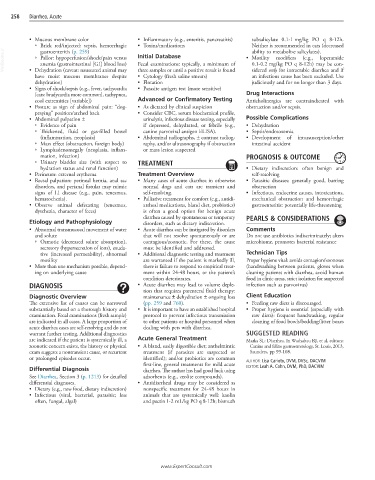Page 572 - Cote clinical veterinary advisor dogs and cats 4th
P. 572
258 Diarrhea, Acute
• Mucous membrane color • Inflammatory (e.g., enteritis, pancreatitis) subsalicylate 0.1-1 mg/kg PO q 8-12h.
○ Brick red/injected: sepsis, hemorrhagic • Toxins/medications Neither is recommended in cats (decreased
VetBooks.ir ○ Pallor: hypoperfusion/shock/pain versus Initial Database • Motility modifiers (e.g., loperamide
ability to metabolize salicylates).
gastroenteritis (p. 259)
Fecal examinations: typically, a minimum of
anemia (gastrointestinal [GI] blood loss)
0.1-0.2 mg/kg PO q 8-12h) may be con-
• Dehydration (caveat: nauseated animal may
have moist mucous membranes despite three samples or until a positive result is found sidered only for intractable diarrhea and if
an infectious cause has been excluded. Use
• Cytology (fresh saline smears)
dehydration) • Flotation judiciously and for no longer than 3 days.
• Signs of shock/sepsis (e.g., fever, tachycardia • Parasite antigen test (more sensitive)
[cats: bradycardia more common], tachypnea, Drug Interactions
cool extremities [variable]) Advanced or Confirmatory Testing Anticholinergics are contraindicated with
• Posture as sign of abdominal pain: “dog- • As dictated by clinical suspicion obstruction and/or sepsis.
praying” position/arched back • Consider CBC, serum biochemical profile,
• Abdominal palpation ± urinalysis, infectious disease testing, especially Possible Complications
○ Evidence of pain if depressed, dehydrated, or febrile (e.g., • Dehydration
○ Thickened, fluid or gas-filled bowel canine parvoviral antigen ELISA). • Sepsis/endotoxemia
(inflammation, neoplasia) • Abdominal radiographs, ± contrast radiog- • Development of intussusception/other
○ Mass effect (obstruction, foreign body) raphy, and/or ultrasonography if obstruction intestinal accident
○ Lymphadenomegaly (neoplasia, inflam- or mass lesion suspected
mation, infection) PROGNOSIS & OUTCOME
○ Urinary bladder size (with respect to TREATMENT
hydration status and renal function) • Dietary indiscretion: often benign and
• Perineum: external erythema Treatment Overview self-resolving
• Rectal palpation: perineal hernia, anal sac • Many cases of acute diarrhea in otherwise • Parasitic diseases: generally good, barring
disorders, and perianal fistulas may mimic normal dogs and cats are transient and obstruction
signs of LI disease (e.g., pain, tenesmus, self-resolving. • Infectious, endocrine causes, intoxications,
hematochezia). • Palliative treatment for comfort (e.g., antidi- mechanical obstruction and hemorrhagic
• Observe animal defecating (tenesmus, arrheal medications, bland diet, probiotics) gastroenteritis: potentially life-threatening
dyschezia, character of feces) is often a good option for benign acute
diarrhea caused by spontaneous or temporary PEARLS & CONSIDERATIONS
Etiology and Pathophysiology disorders, such as dietary indiscretion.
• Abnormal transmucosal movement of water • Acute diarrhea can be instigated by disorders Comments
and solute that will not resolve spontaneously or are Do not use antibiotics indiscriminately; alters
○ Osmotic (decreased solute absorption), contagious/zoonotic. For these, the cause microbiome, promotes bacterial resistance
secretory (hypersecretion of ions), exuda- must be identified and addressed.
tive (increased permeability), abnormal • Additional diagnostic testing and treatment Technician Tips
motility are warranted if the patient is markedly ill, Proper hygiene vital: avoids contagion/zoonoses
• More than one mechanism possible, depend- there is failure to respond to empirical treat- (handwashing between patients, gloves when
ing on underlying cause ment within 24-48 hours, or the patient’s cleaning patients with diarrhea, avoid human
condition deteriorates. food in clinic areas, strict isolation for suspected
DIAGNOSIS • Acute diarrhea may lead to volume deple- infection such as parvovirus)
tion that requires parenteral fluid therapy:
Diagnostic Overview maintenance ± dehydration ± ongoing loss Client Education
The extensive list of causes can be narrowed (pp. 259 and 760). • Feeding raw diets is discouraged.
substantially based on a thorough history and • It is important to have an established hospital • Proper hygiene is essential (especially with
examination. Fecal examinations (fresh sample) protocol to prevent infectious transmission raw diets): frequent handwashing, regular
are indicated in all cases. A large proportion of to other patients or hospital personnel when cleaning of food bowls/bedding/litter boxes
acute diarrhea cases are self-resolving and do not dealing with pets with diarrhea.
warrant further testing. Additional diagnostics SUGGESTED READING
are indicated if the patient is systemically ill, a Acute General Treatment Marks SL: Diarrhea. In Washabau RJ, et al, editors:
zoonotic concern exists, the history or physical • A bland, easily digestible diet; anthelmintic Canine and feline gastroenterology, St. Louis, 2013,
exam suggests a nontransient cause, or recurrent treatment (if parasites are suspected or Saunders, pp 99-108.
or prolonged episodes occur. identified); and/or probiotics are common AUTHOR: Lisa Carioto, DVM, DVSc, DACVIM
first-line, general treatments for mild acute
Differential Diagnosis diarrhea. The author has had good luck using EDITOR: Leah A. Cohn, DVM, PhD, DACVIM
See Diarrhea, Section 3 (p. 1213) for detailed adsorbents (e.g., zeolite compounds).
differential diagnoses. • Antidiarrheal drugs may be considered as
• Dietary (e.g., new food, dietary indiscretion) nonspecific treatment for 24-48 hours in
• Infectious (viral, bacterial, parasitic; less animals that are systemically well: kaolin
often, fungal, algal) and pectin 1-2 mL/kg PO q 8-12h; bismuth
www.ExpertConsult.com

